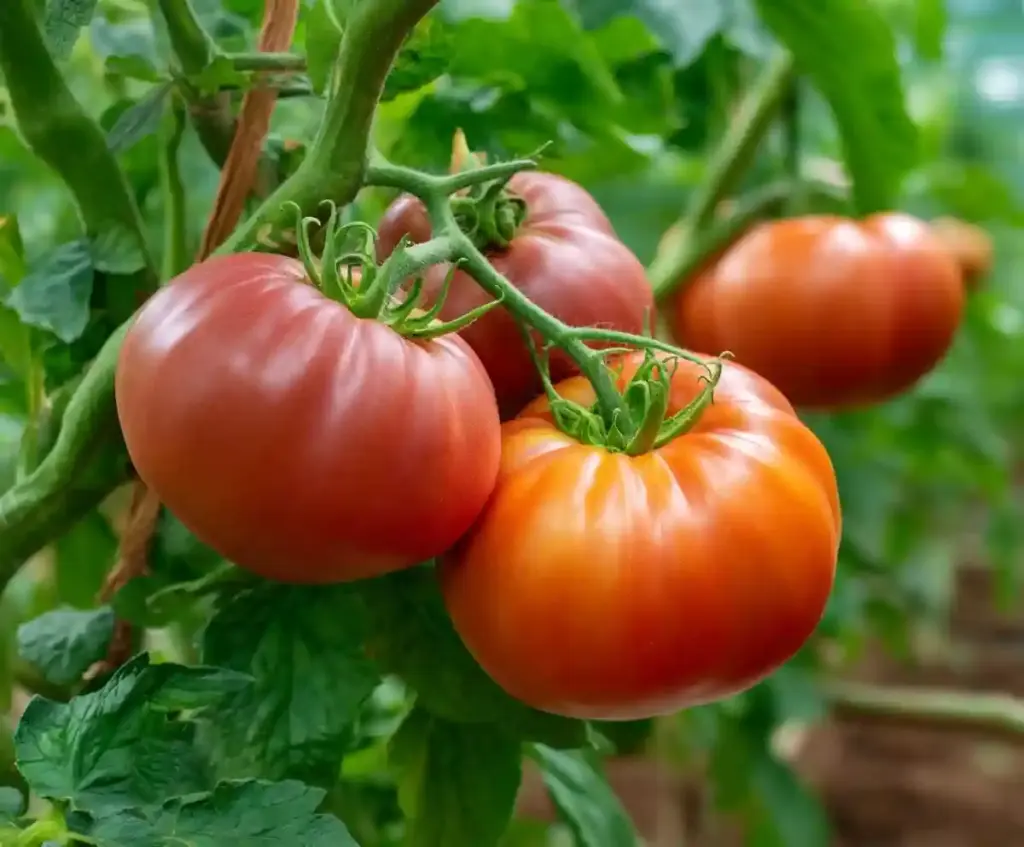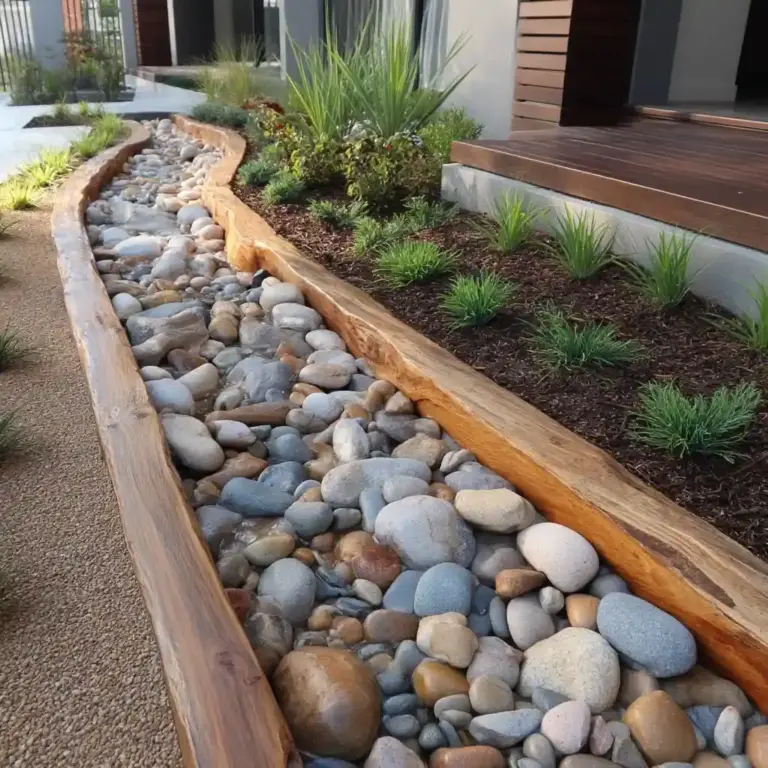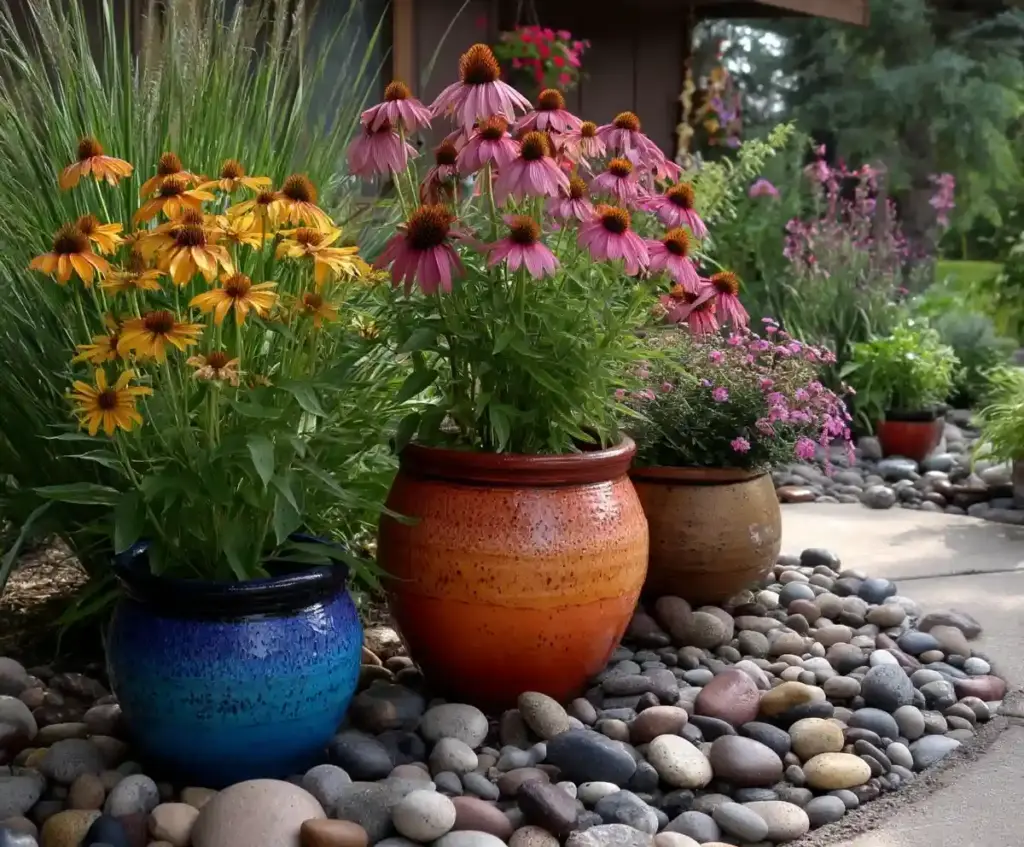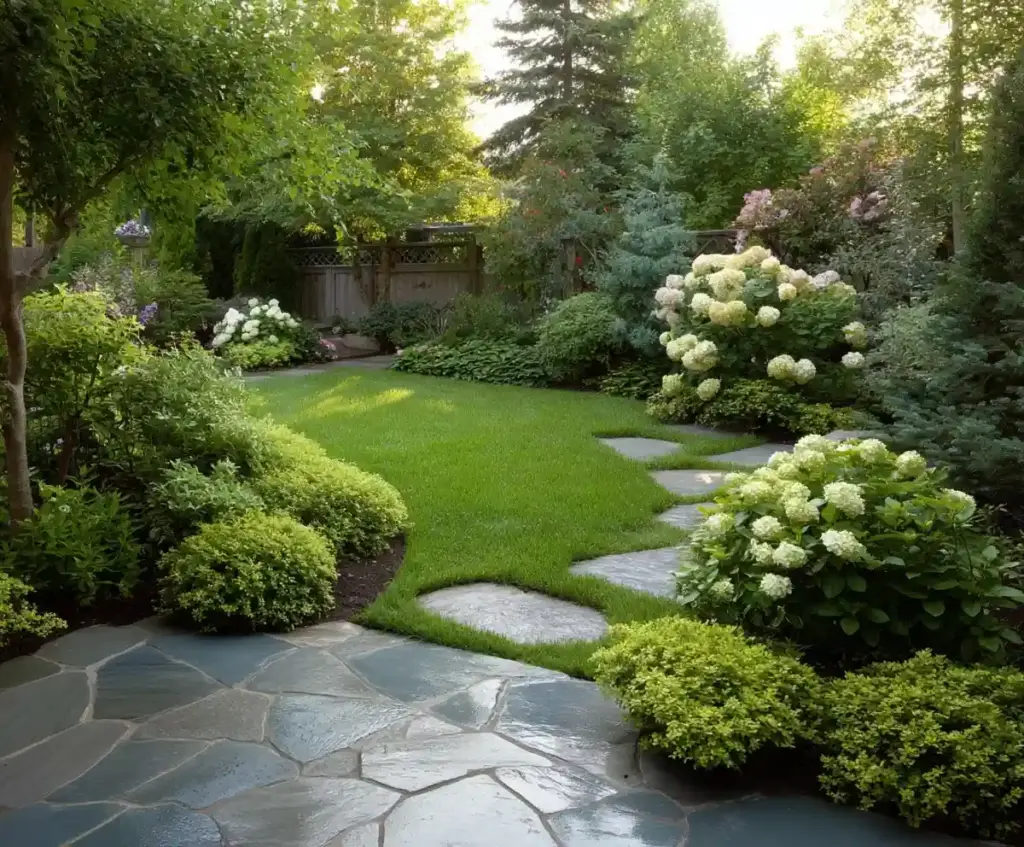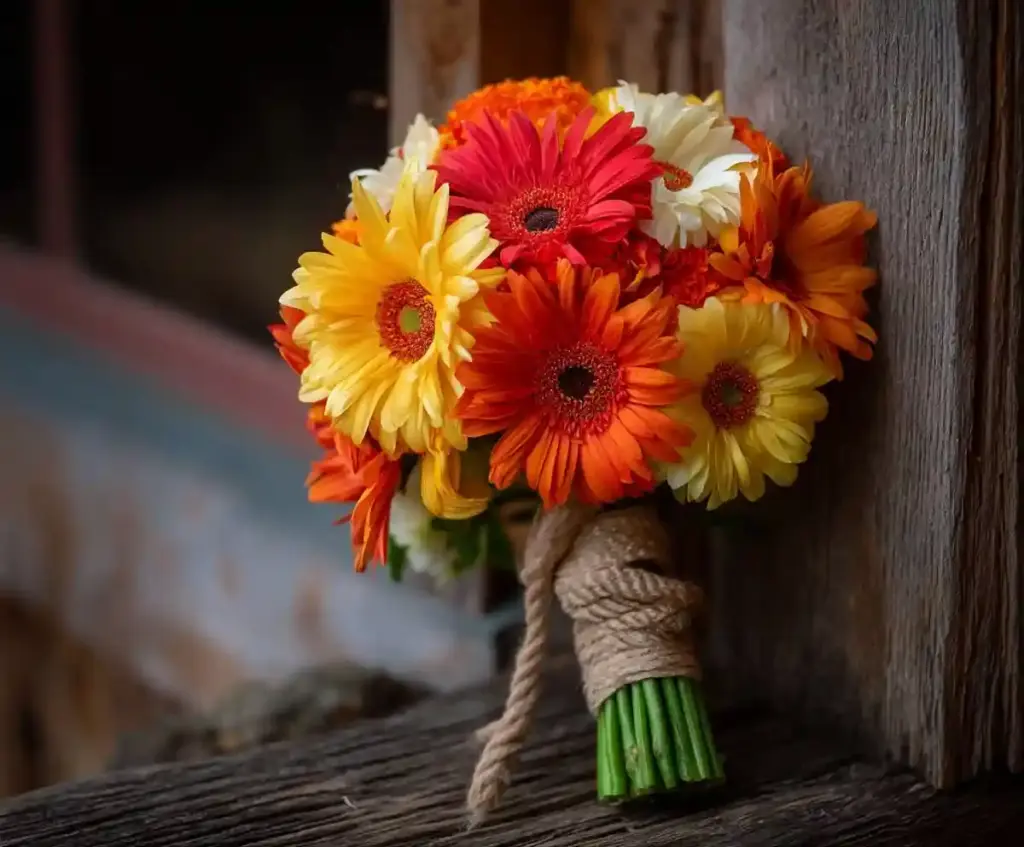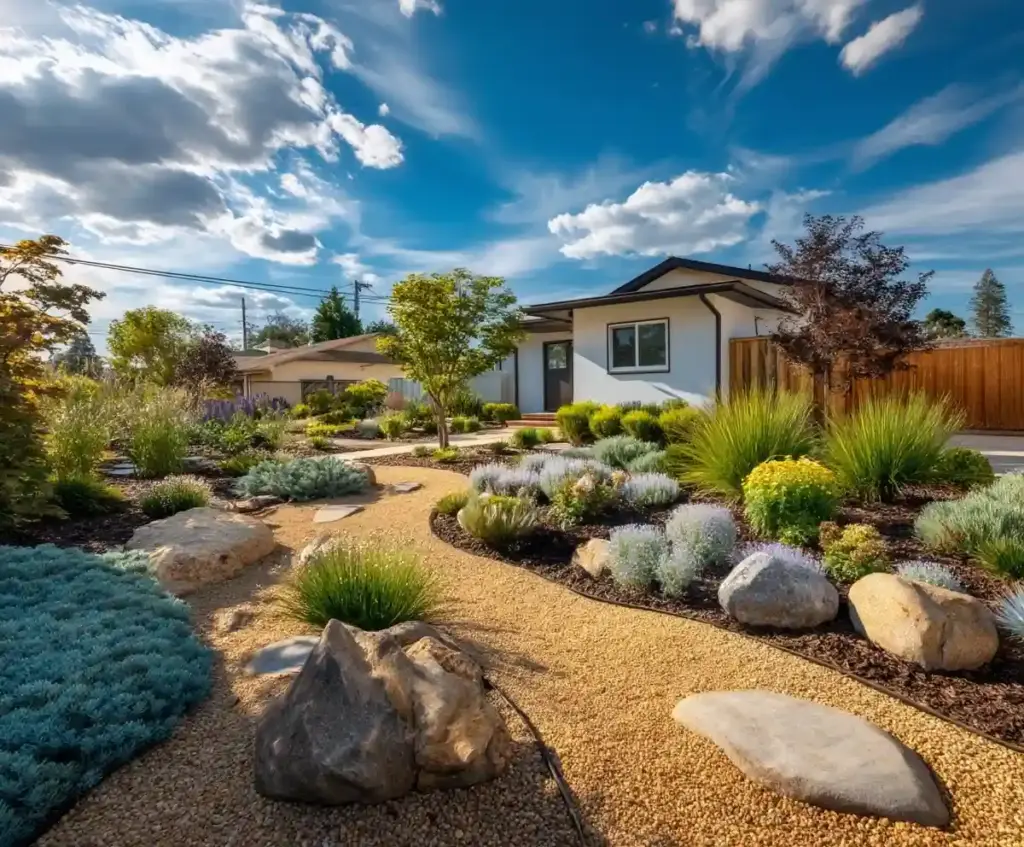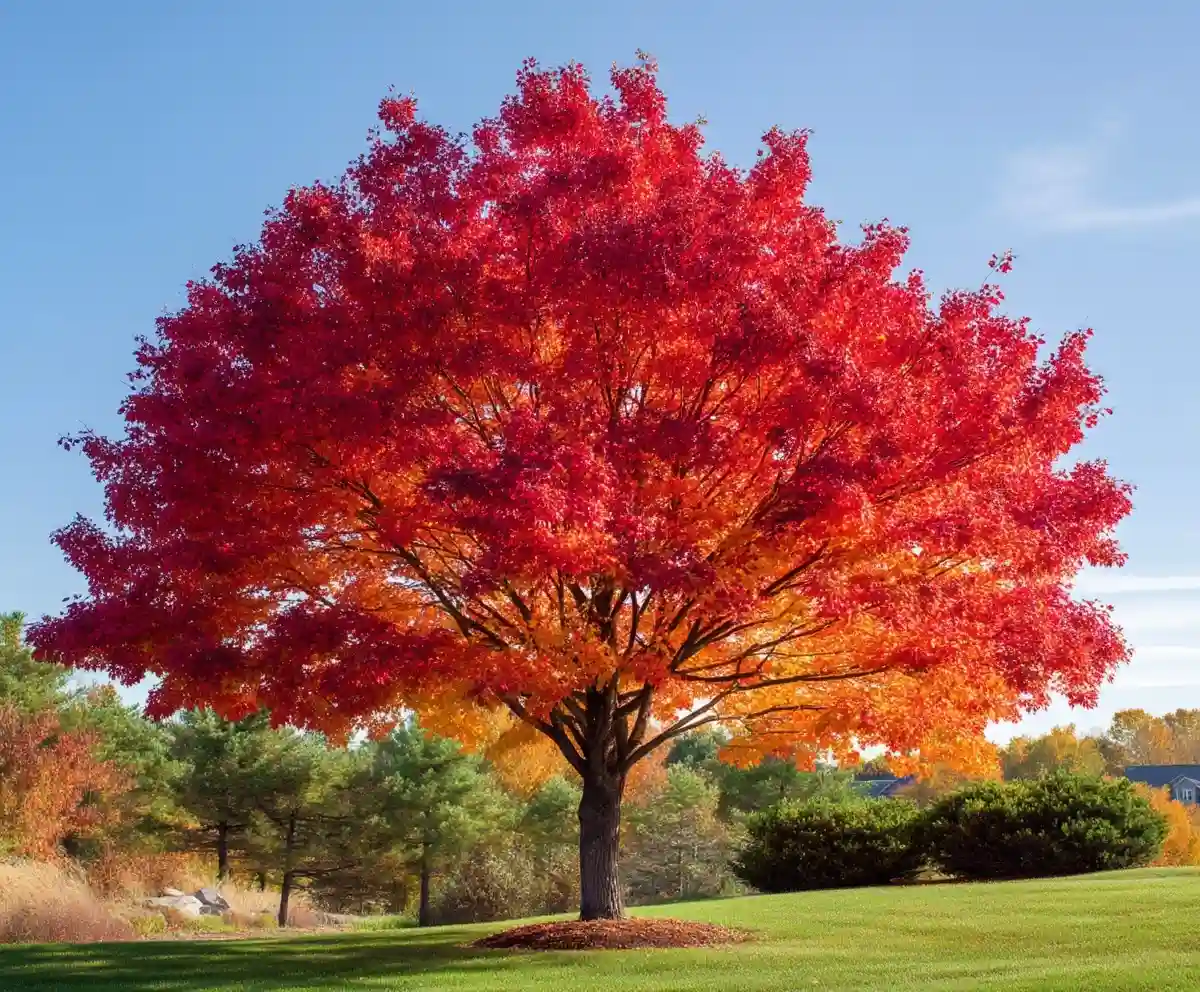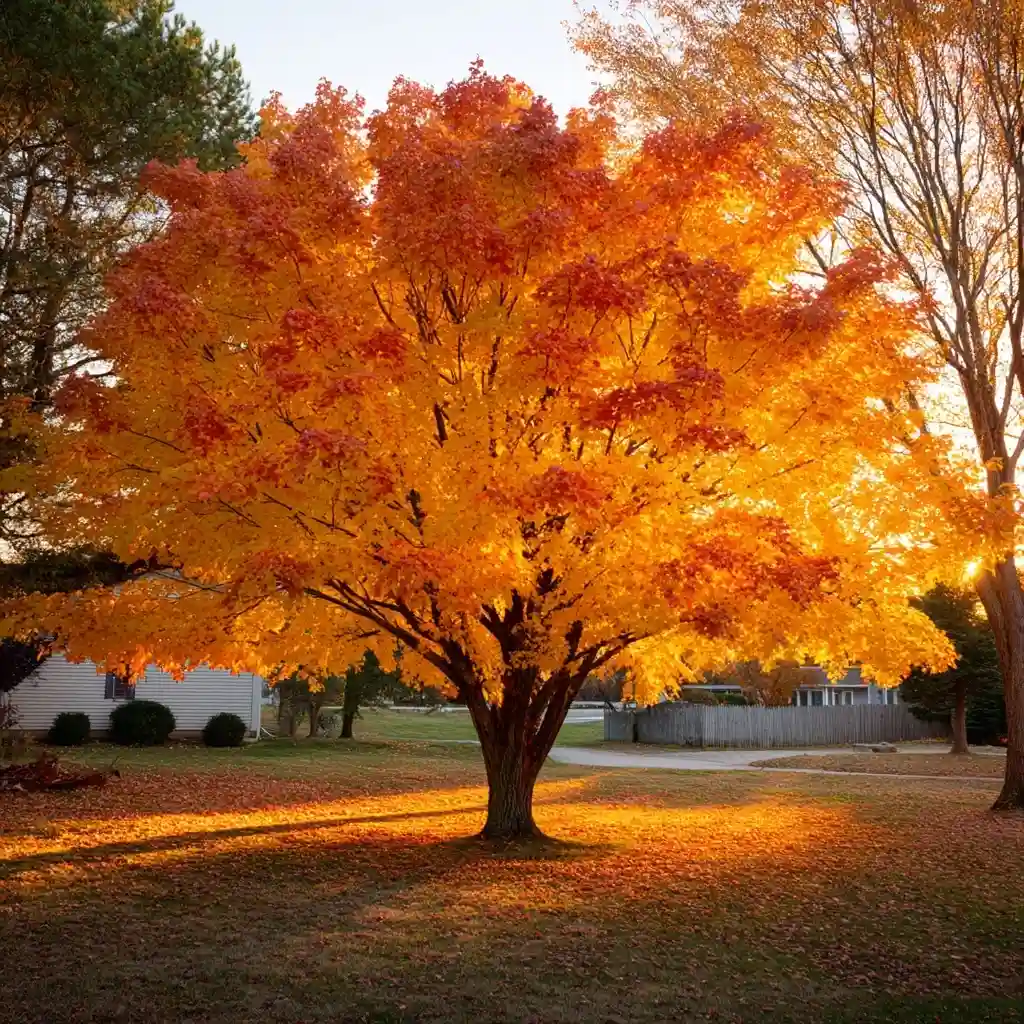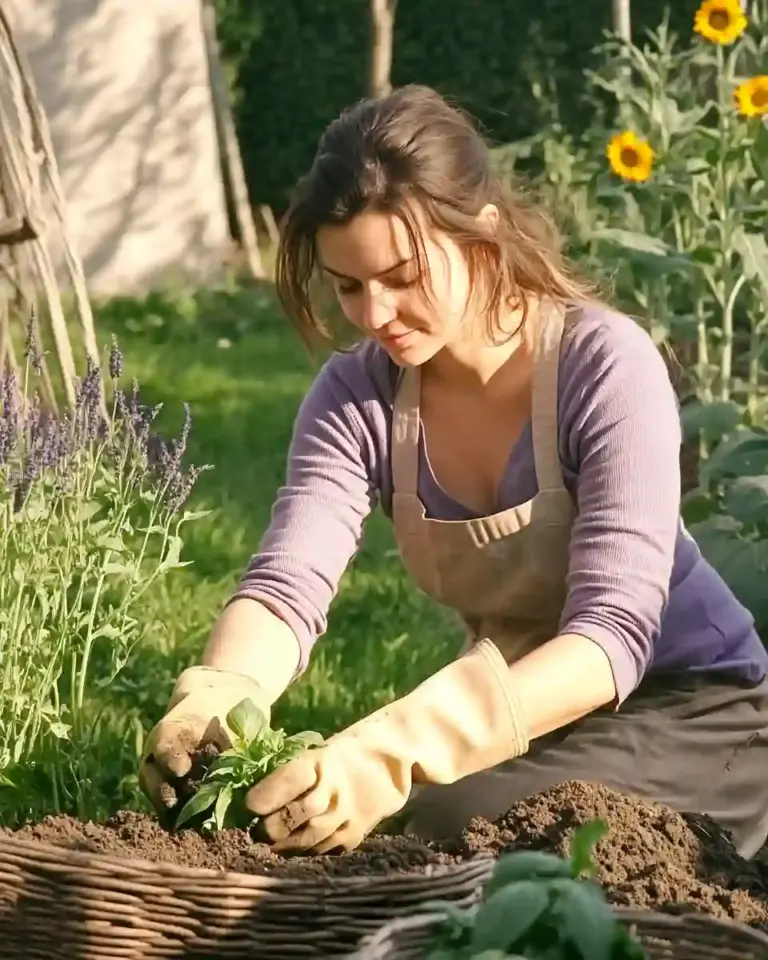Best fall trees for color can transform your yard into a breathtaking autumn scene, filled with shades of crimson, gold, and fiery orange. As the days grow cooler and the sunlight softens, these trees bring a burst of life to the landscape just when summer’s blooms begin to fade. Whether you have a sprawling property or a small garden, there’s a variety suited to your space and climate. From towering maples that blaze with red and orange to smaller ornamentals that shimmer in yellow, choosing the right fall tree ensures your yard becomes a seasonal highlight year after year.
Table of Contents
1. Sugar Maple
The sugar maple is one of the best fall trees for color, producing an unmatched mix of red, orange, and yellow leaves. Each autumn, its canopy turns into a glowing tapestry that can stop you in your tracks. Individual trees can vary in their color display from year to year, adding a bit of surprise to the season.
Growing between 40 and 80 feet tall, this native North American tree thrives in USDA Zones 3–8. It prefers medium-moisture, well-drained soil and does best in full sun to partial shade. Though slow-growing, it develops into a stately shade tree that’s as useful as it is beautiful.
Aside from its fall brilliance, the sugar maple has another claim to fame: it’s the source of maple syrup. In late winter, its sap is collected and boiled down to create the sweet treat many of us enjoy on pancakes and waffles.
2. Red Maple
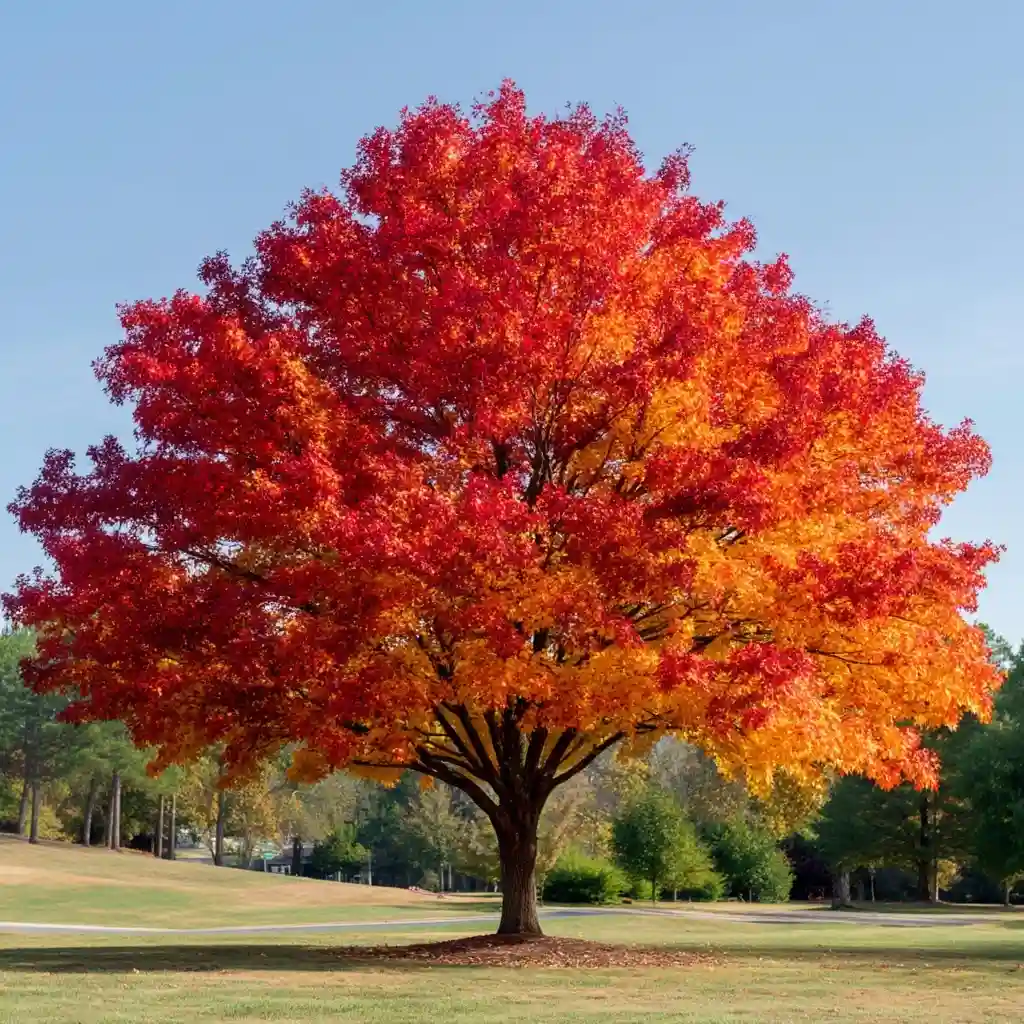
The red maple earns its spot among the best fall trees for color by putting on a show in nearly every season. In autumn, its leaves glow deep red or turn warm golden yellow, depending on the year and growing conditions.
This fast-growing tree reaches 30 to 50 feet tall and thrives in USDA Zones 3–9. It adapts well to a wide range of soils, from medium moisture to wetter ground, making it a versatile choice for different landscapes. Full sun to partial shade provides the best leaf color.
One of its standout qualities is year-round interest—red flowers in spring, reddish stems in summer, and red buds in winter. Whether you’re planting for fall impact or all-season beauty, the red maple delivers.
3. Japanese Maple
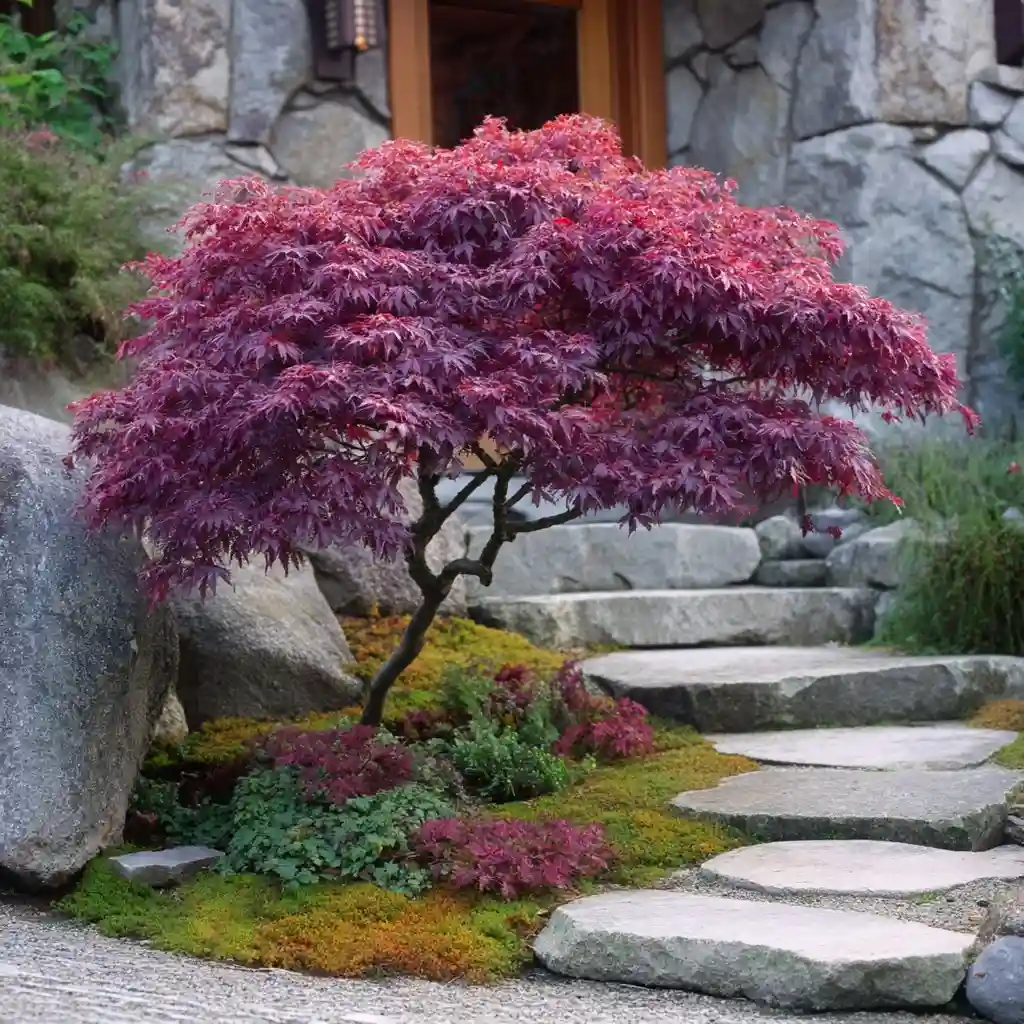
The Japanese maple is a smaller ornamental that still ranks high among the best fall trees for color. Its finely cut leaves often turn rich shades of red, burgundy, or orange, creating a striking focal point in the garden.
Typically growing 10 to 25 feet tall, it thrives in USDA Zones 5–8. It prefers rich, moist, slightly acidic soil and does well in full sun to partial shade. In hotter climates, some afternoon shade can help preserve leaf color and prevent scorching.
Varieties like the ‘Crimson Queen’ offer cascading branches and a graceful silhouette, perfect for smaller yards or container planting. Beyond fall, Japanese maples provide spring and summer beauty, ensuring they shine in all seasons.
4. Black Gum / Black Tupelo
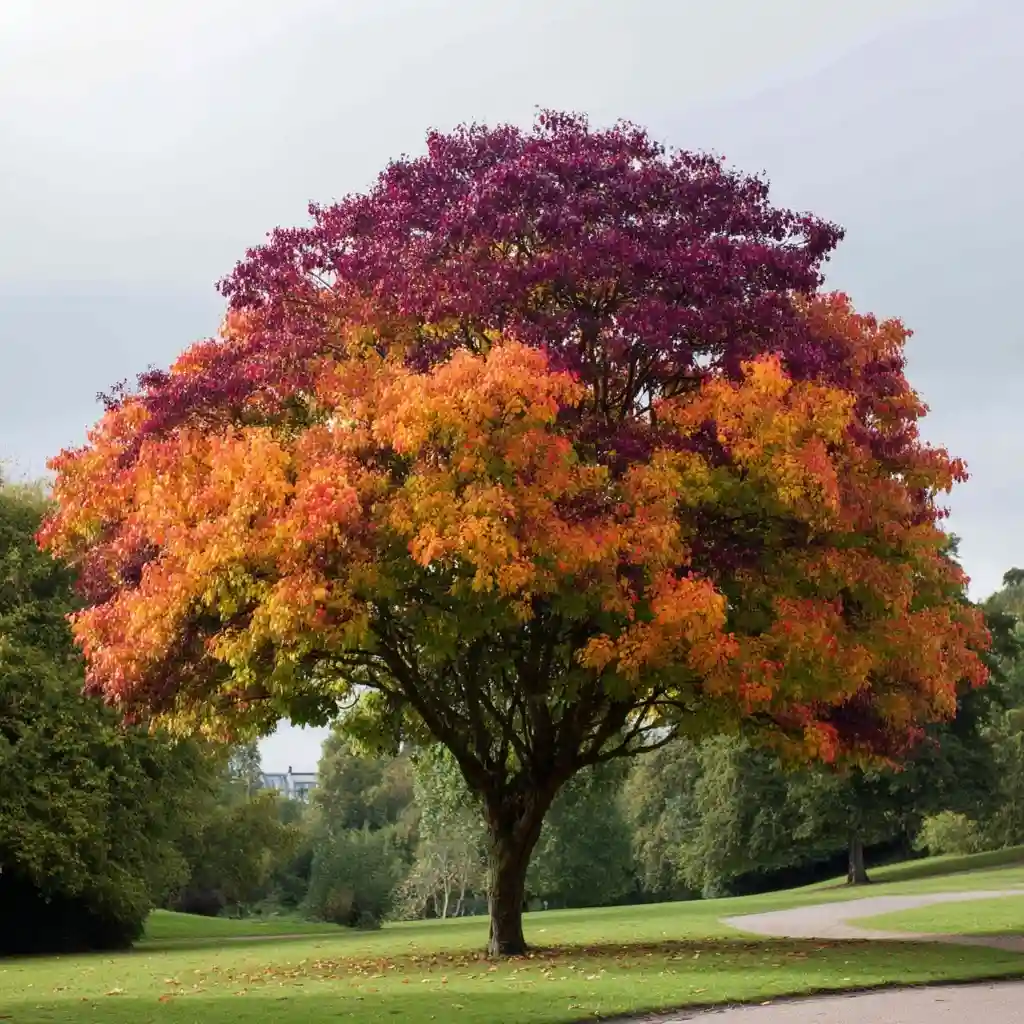
The black gum, also called black tupelo, is one of the best fall trees for color thanks to its glossy green leaves that transform into vibrant red, orange, yellow, and even purple in autumn. Its multi-toned display often makes it the star of the season.
Reaching 30 to 50 feet tall, it grows well in USDA Zones 4–9 and tolerates a variety of soils, from medium moisture to wetter sites—even areas with occasional standing water. Full sun to partial shade will give the brightest fall color.
Beyond its foliage, black gum offers ecological benefits. Birds enjoy its small dark fruits, and bees visit its flowers in late spring. Planting one adds both visual beauty and wildlife value to your yard.
5. Witch Hazel
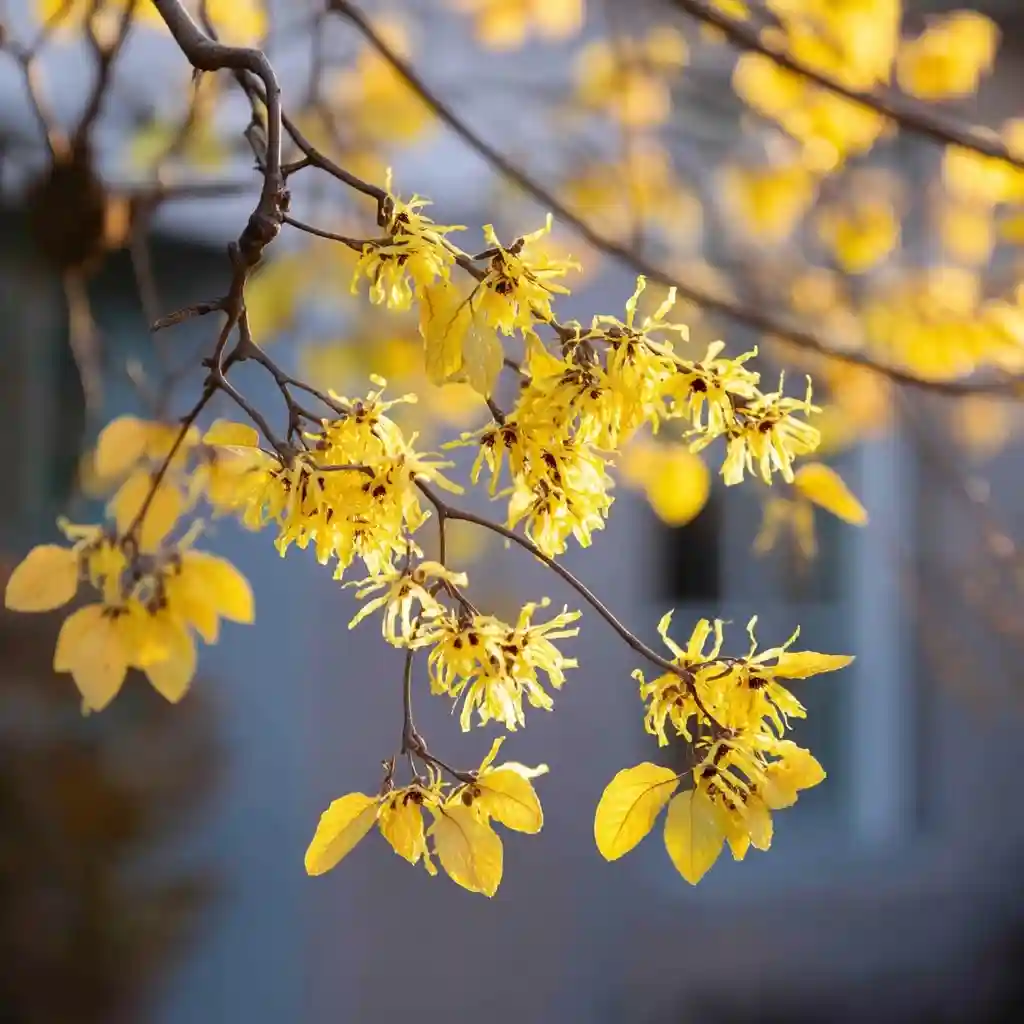
Witch hazel is a versatile choice among the best fall trees for color, offering a burst of bright yellow leaves late in the season. It can be grown as a large shrub or a small tree, making it ideal for both spacious landscapes and smaller gardens.
Typically reaching 15 to 30 feet tall, it thrives in USDA Zones 3–8. It prefers moist, well-drained soil but adapts to a range of soil types. This hardy plant tolerates full sun to full shade, giving it flexibility in placement.
In addition to its fall foliage, witch hazel produces fragrant, ribbon-like yellow flowers in late fall or even winter, brightening the garden when most other plants are bare.
6. Ginkgo
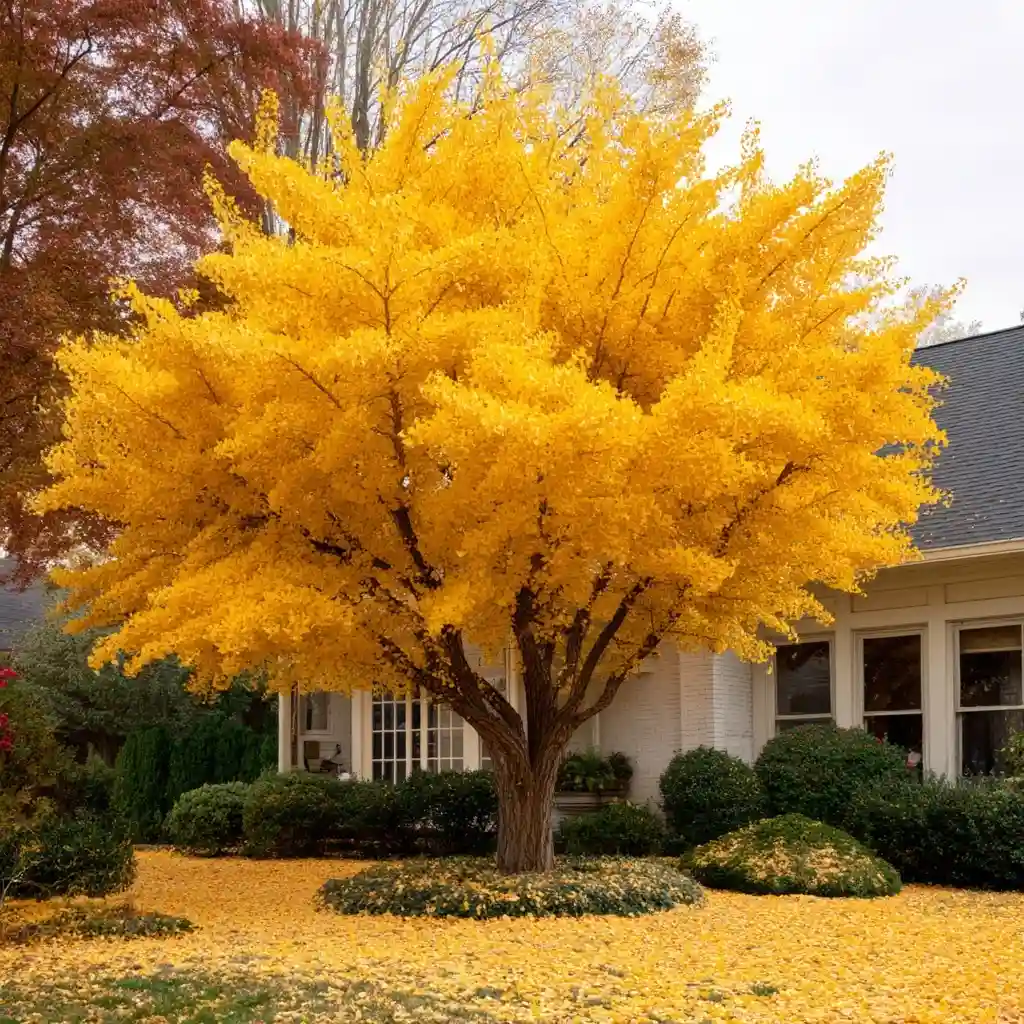
The ginkgo is a living fossil and a standout among the best fall trees for color, famous for its fan-shaped leaves that turn a brilliant golden yellow before falling. Its autumn display is striking, especially when planted in groups.
Capable of growing up to 100 feet tall, it thrives in USDA Zones 3–8. Ginkgos prefer moist, well-drained soil but adapt well to urban environments and less-than-ideal conditions. They tolerate full sun to partial shade.
One of their unique traits is how they shed leaves—often all at once—creating a golden carpet beneath the tree. Slow-growing but long-lived, ginkgos bring both elegance and resilience to any yard.
7. Shadblow Serviceberry
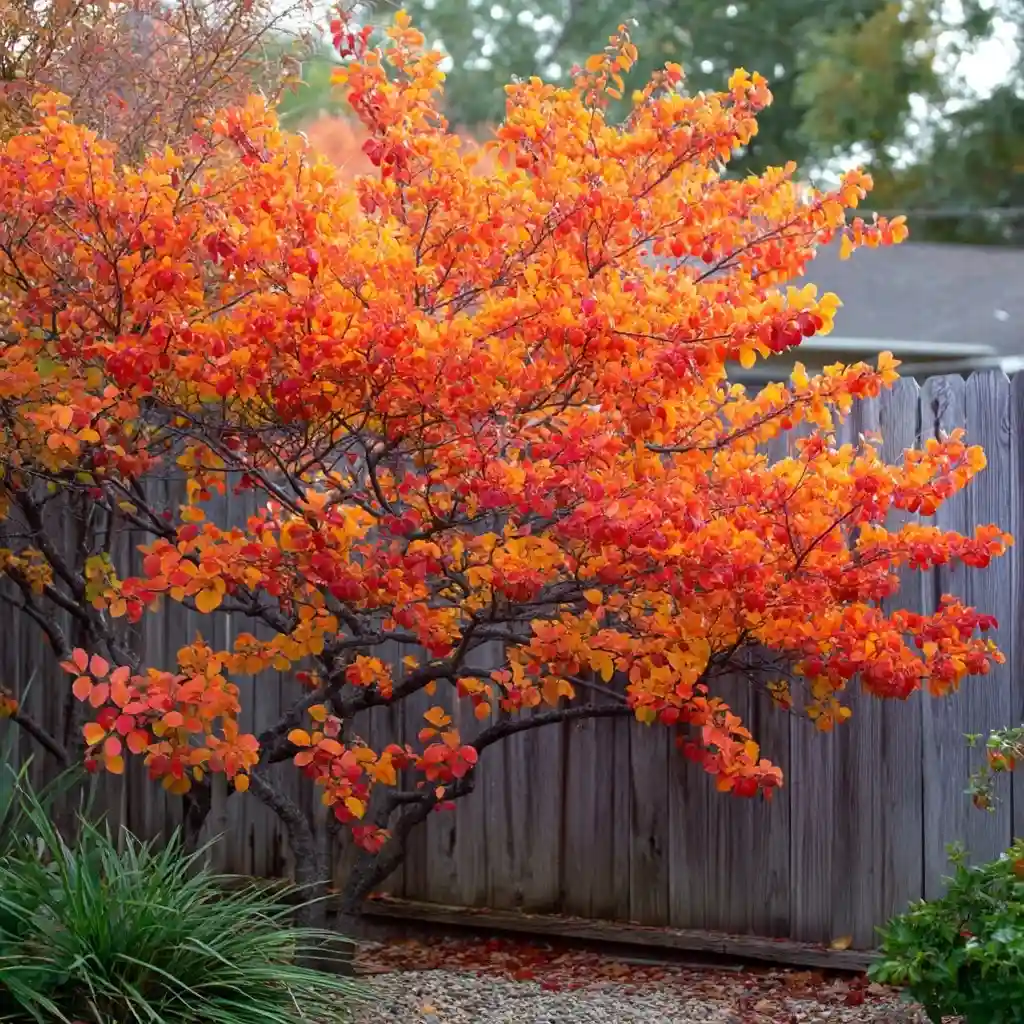
The shadblow serviceberry is a multi-season beauty and one of the best fall trees for color, turning a rich orange-red when the weather cools. In spring, it produces clusters of delicate white flowers, followed by edible berries that attract birds.
This small tree reaches 25 to 30 feet tall and grows well in USDA Zones 4–8. It prefers well-drained soil but tolerates a range of soil conditions. Full sun to partial shade works best for strong flowering and vivid autumn color.
Because of its modest size, the shadblow serviceberry fits perfectly into smaller yards, adding ornamental charm without overwhelming the space.
8. River Birch
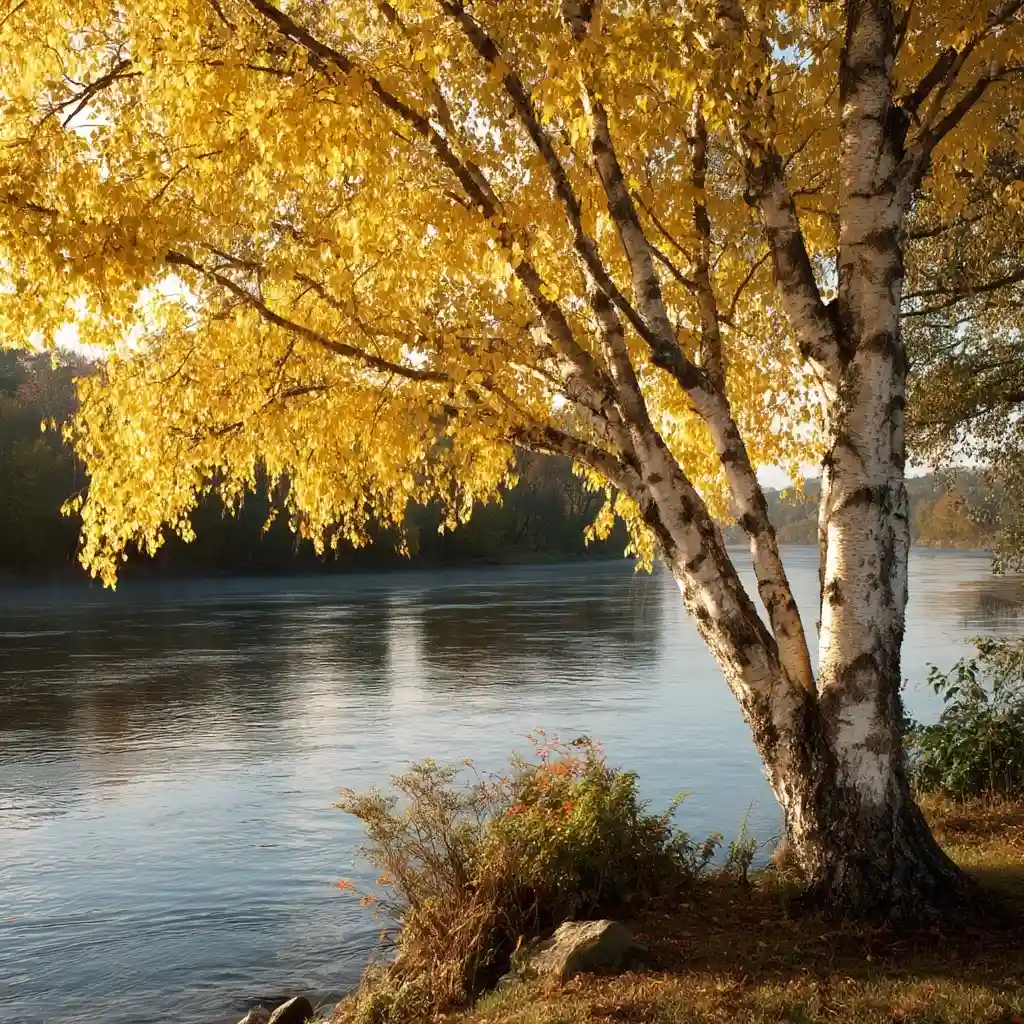
The river birch earns a place among the best fall trees for color with its bright yellow autumn leaves and striking, peeling bark that adds texture year-round. Even in winter, its cinnamon-toned bark provides visual interest.
Growing 40 to 70 feet tall, it thrives in USDA Zones 4–9. While it loves moist, well-drained soil and is often found near riverbanks, it adapts well to a variety of conditions, including wetter sites. Full sun to partial shade helps produce the best foliage color.
Its fast growth, unique bark, and vibrant fall display make the river birch an attractive choice for both ornamental and functional landscaping.
9. American Sweetgum
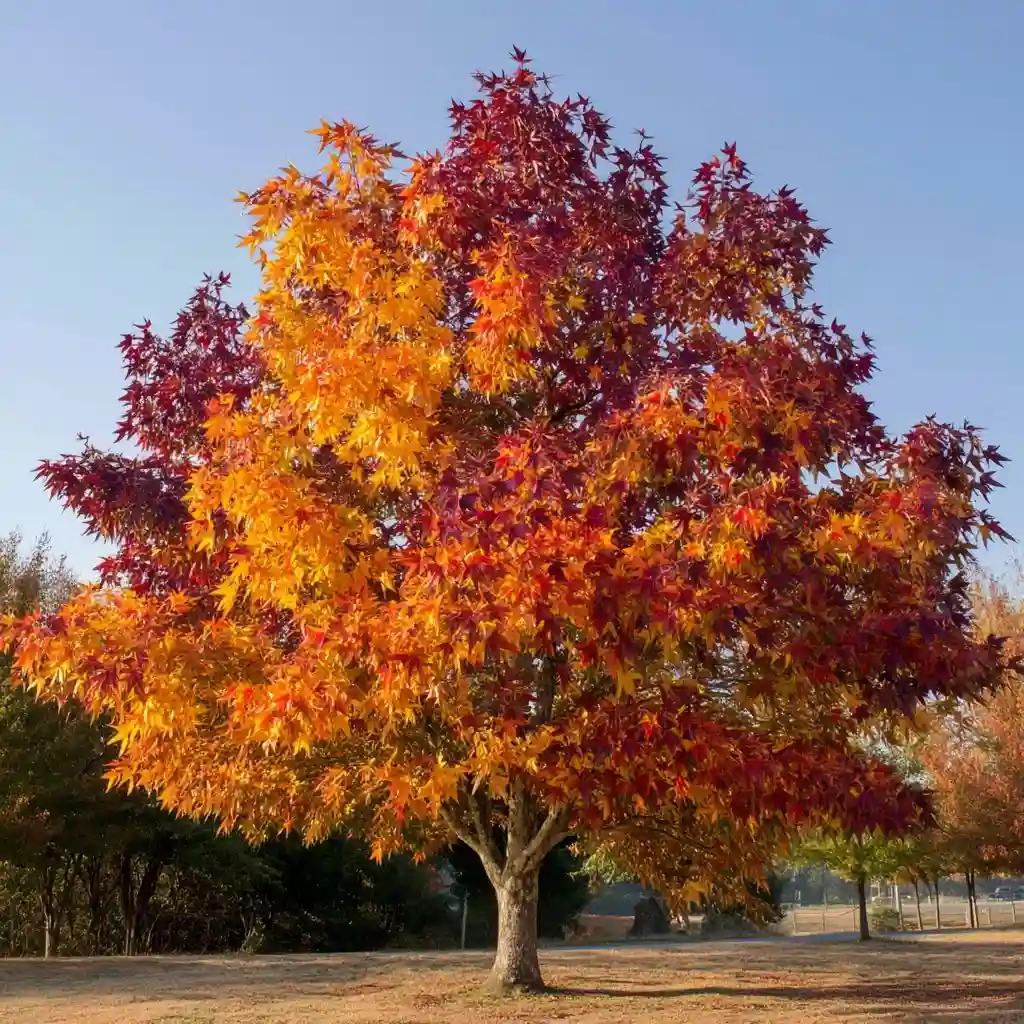
The American sweetgum is one of the best fall trees for color, delivering a kaleidoscope of yellow, orange, red, and deep burgundy leaves that often linger well into late autumn. Its star-shaped foliage and spiky seed pods give it a distinctive look.
This tree can reach up to 80 feet tall and thrives in USDA Zones 5–9. It prefers medium-moisture, well-drained soil and does best in full sun. Avoid planting in alkaline soils, as they can affect its health and color quality.
While the seed pods may be a bit of a cleanup chore, some gardeners use them in crafts or holiday decorations. Its long-lasting color display more than makes up for the extra effort.
10. Northern Red Oak
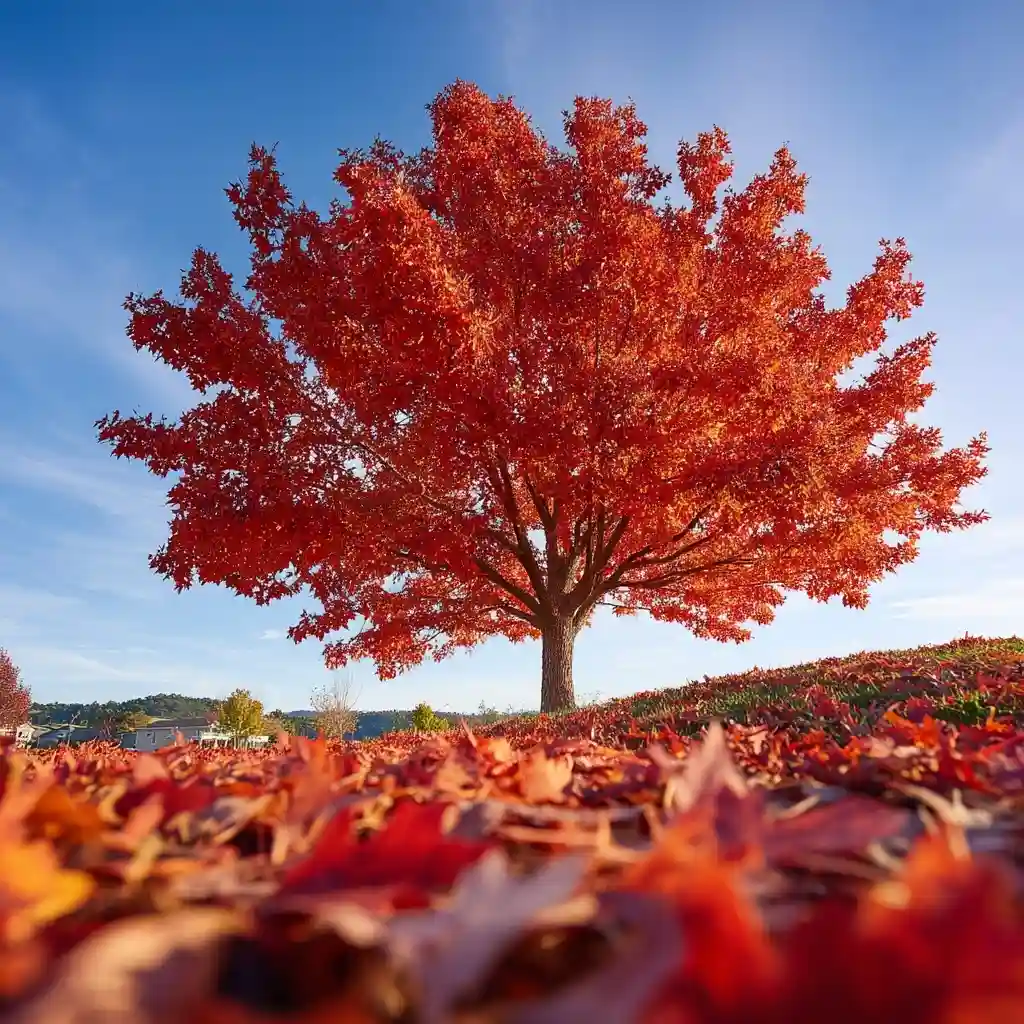
The northern red oak stands tall among the best fall trees for color, showing off rich red foliage that often appears later in the season. Its leaves tend to stay on the branches longer than many other trees, extending the autumn display.
Reaching up to 80 feet in height, this hardy tree thrives in USDA Zones 3–8. It prefers well-drained soil and grows best in full sun to partial shade. Its strong wood and stately form make it a long-lasting addition to the landscape.
Because of its size and spreading canopy, the northern red oak works well as a shade tree while providing spectacular seasonal color.
11. Oakleaf Hydrangea (Shrub)
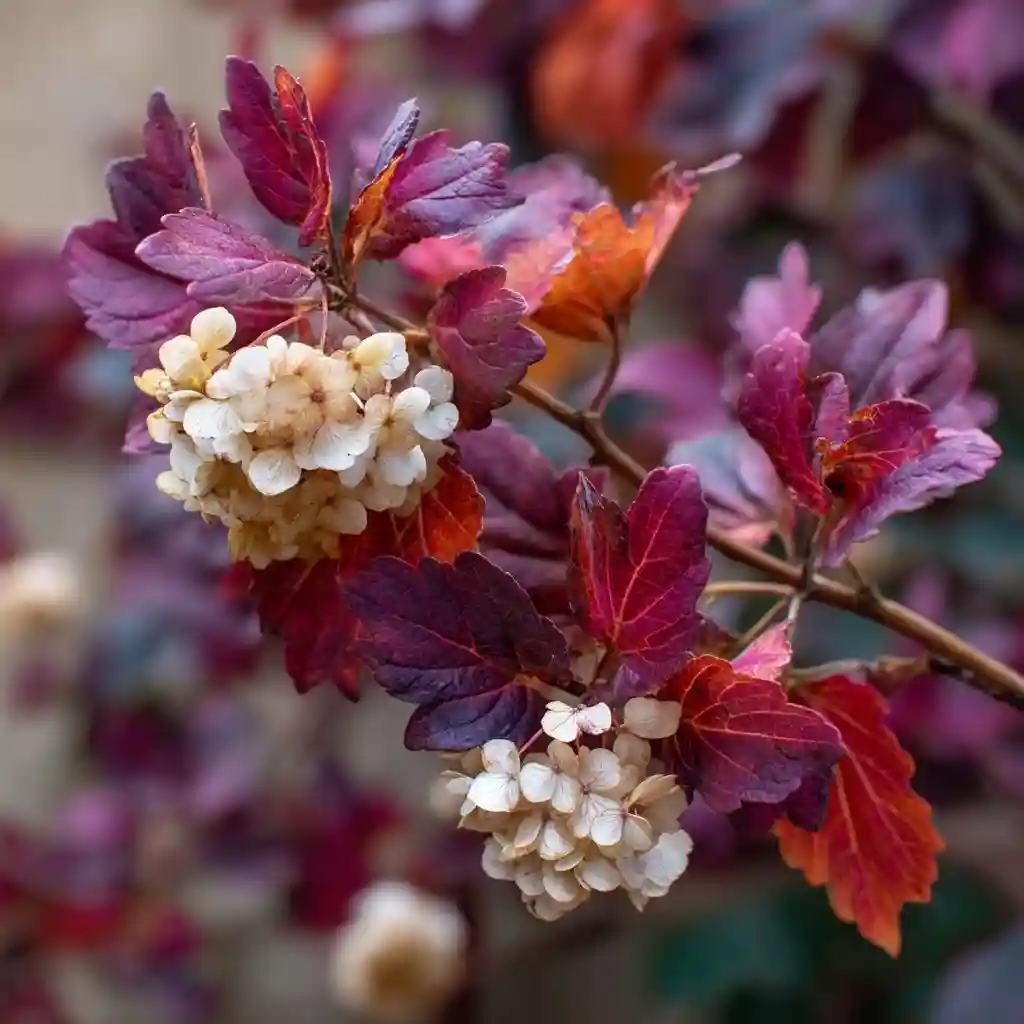
While technically a shrub, the oakleaf hydrangea deserves a mention among the best fall trees for color because of its deep red, orange, and purple foliage that lasts well into winter. Its large, lobed leaves resemble those of an oak tree, giving it a bold texture in the garden.
Typically growing 4 to 8 feet tall, it thrives in USDA Zones 5–9. Oakleaf hydrangeas prefer rich, moist, well-drained soil and do well in full sun or light shade. Too much shade can reduce flowering, while too much sun in hot climates may scorch leaves.
In spring, they produce large white flower clusters that gradually turn pink, offering beauty long before the fall colors arrive.
12. Sourwood
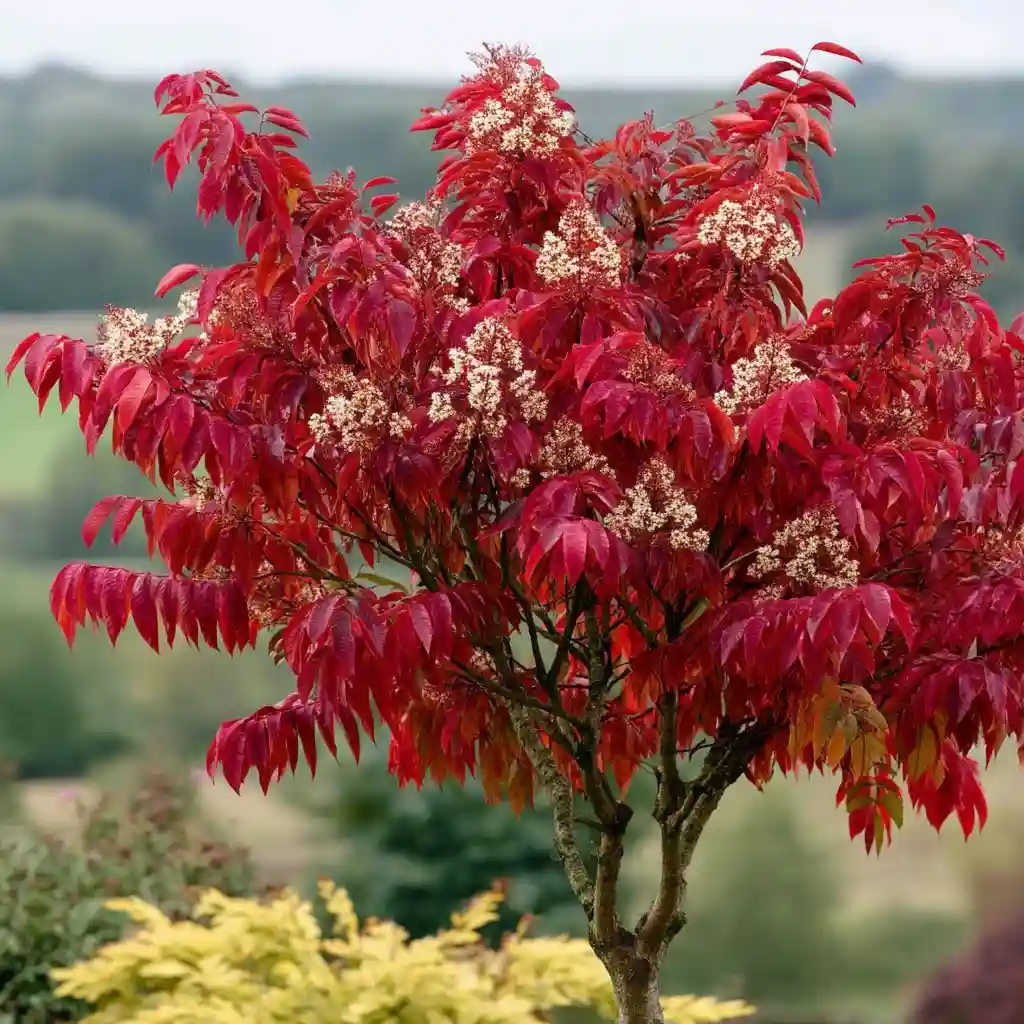
Sourwood is a standout among the best fall trees for color, turning a brilliant crimson red in autumn. Its glossy green summer leaves provide a lush backdrop for fragrant, drooping clusters of white flowers that bloom in midsummer.
Reaching 20 to 50 feet tall, it thrives in USDA Zones 5–9. Sourwood prefers acidic, organically rich, well-drained soil and grows best in full sun, although it can handle light shade. Its upright form makes it an elegant choice for both large and medium-sized yards.
Aside from its beauty, sourwood nectar is prized by beekeepers for producing a uniquely flavored honey.
13. White Oak
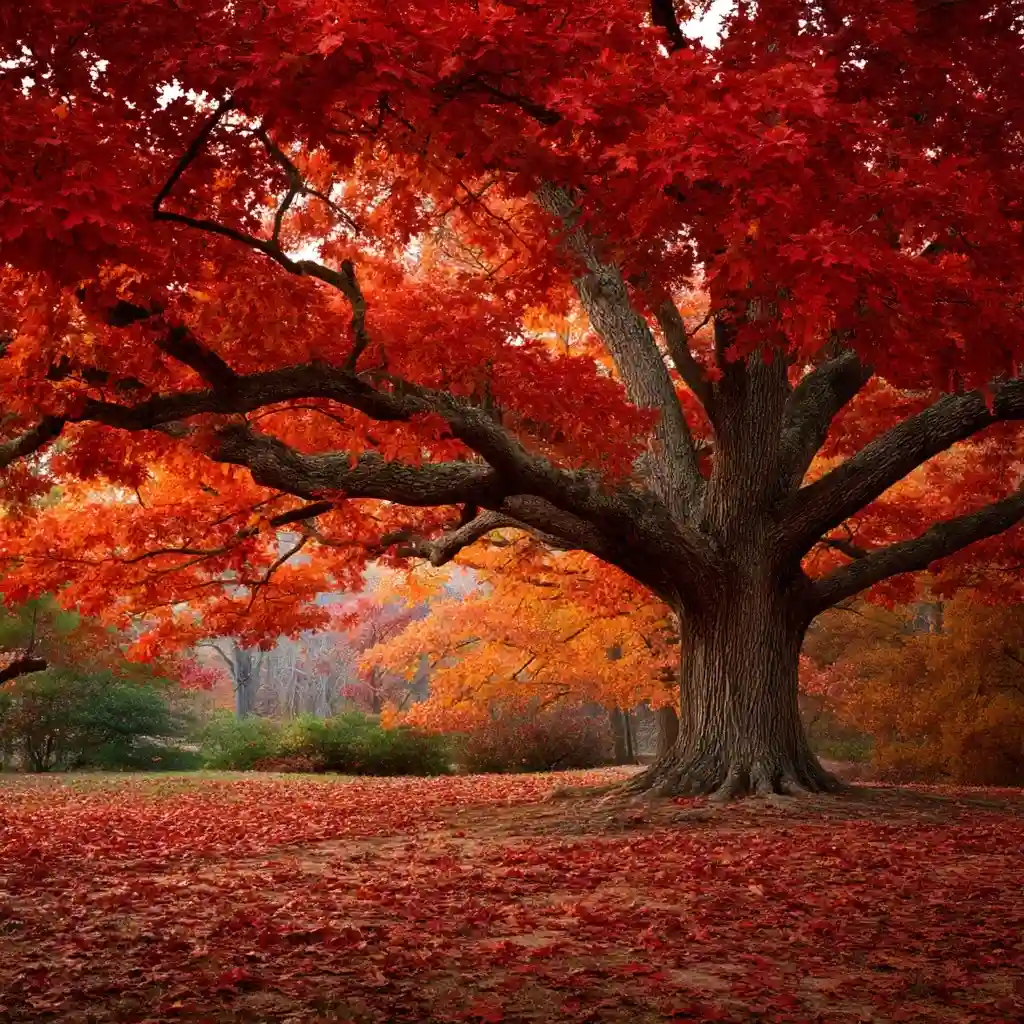
The white oak is a classic choice among the best fall trees for color, with leaves that shift from soft green to deep red or burgundy as autumn progresses. Its broad, rounded crown and strong branches make it an impressive focal point in large landscapes.
Growing up to 80 feet tall, it thrives in USDA Zones 3–9. This adaptable tree prefers rich, moist, well-drained soil and does best in full sun or light shade. While it can grow in a variety of habitats, it often thrives in lowland areas.
Beyond its seasonal beauty, white oak wood is highly valued for its strength and durability, making this tree both ornamental and practical.
14. Bald Cypress
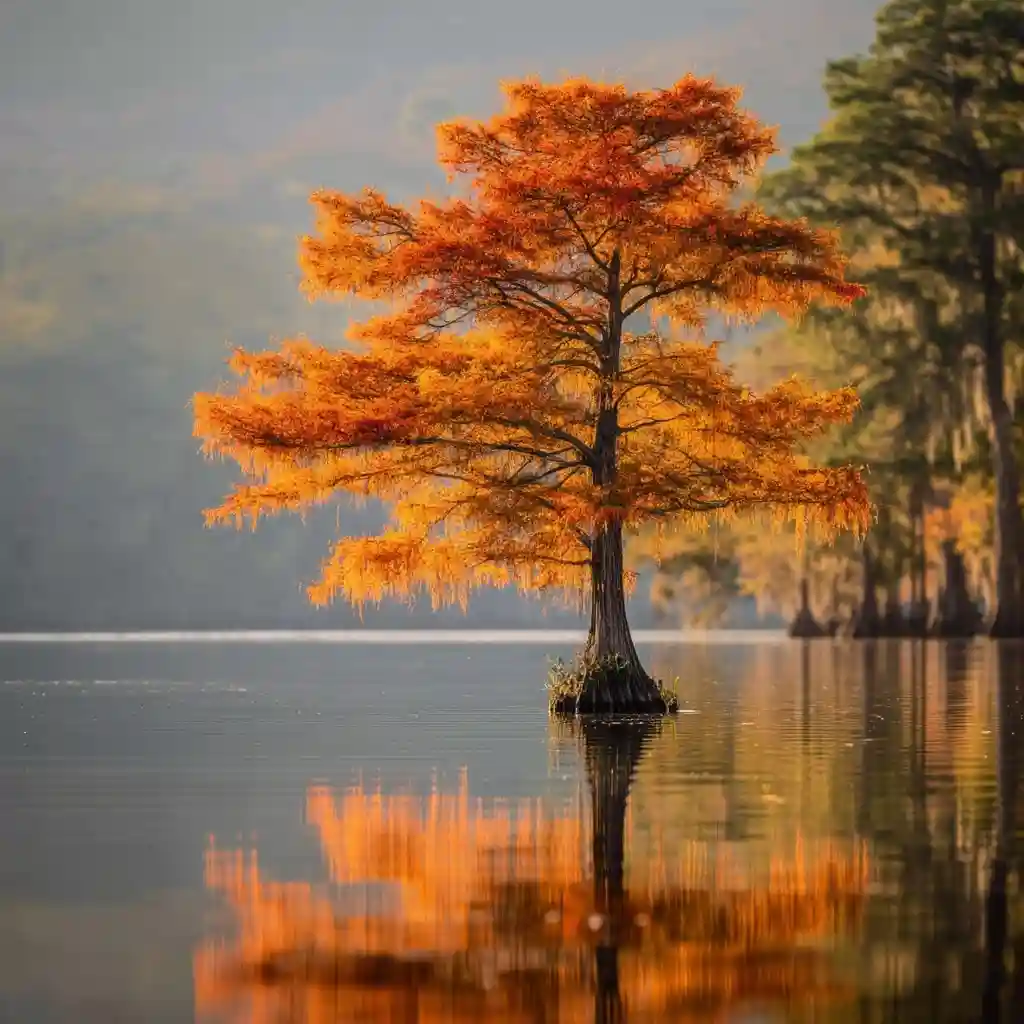
The bald cypress may be famous for its swampy Southern roots, but it’s also one of the best fall trees for color. In autumn, its soft, feathery needles turn a warm orange-cinnamon brown before dropping, giving it a striking seasonal glow.
Reaching up to 70 feet tall, it thrives in USDA Zones 4–10. This adaptable tree prefers rich, moist, well-drained soil but can grow in both wet and dry locations. Full sun is ideal for strong growth and vibrant fall color.
Despite being a conifer, the bald cypress is deciduous, shedding its needles in winter and revealing a graceful, fluted trunk that adds interest even in the dormant season.
15. Flowering Dogwood
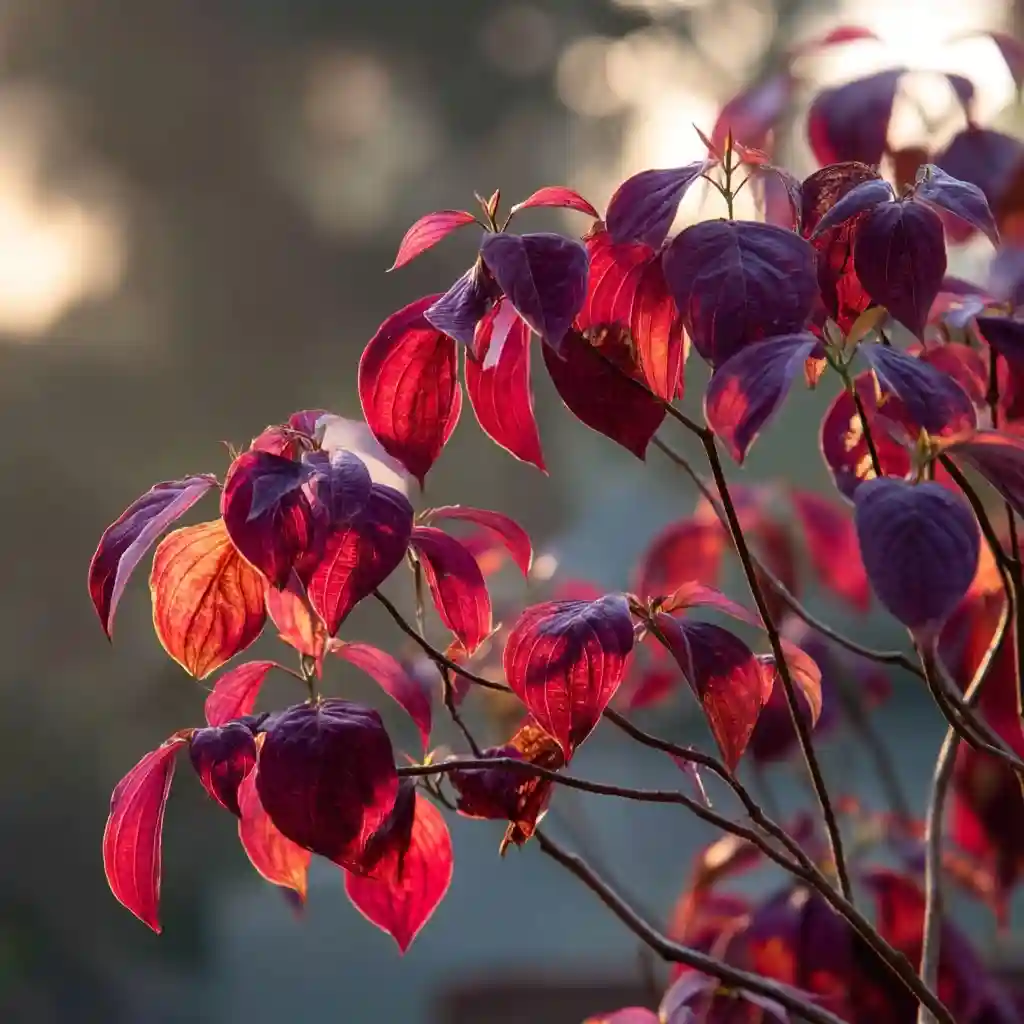
The flowering dogwood is a four-season favorite and one of the best fall trees for color, offering rich red or burgundy foliage each autumn. In spring, it blooms with large, showy white or pink flowers, followed by bright red berries that attract birds.
Typically growing 15 to 30 feet tall, it thrives in USDA Zones 5–9. It prefers moist, well-drained, slightly acidic soil and benefits from partial shade, especially in hotter regions. Too much sun can scorch its delicate leaves.
With its manageable size and year-round interest, the flowering dogwood is perfect for adding elegance and seasonal drama to small and medium gardens alike.
Conclusion
Choosing the best fall trees for color can transform your yard into a seasonal masterpiece. Whether you prefer the fiery reds of a sugar maple, the golden brilliance of a ginkgo, or the multi-hued display of a sweetgum, there’s a tree for every space and climate. Planting these beauties not only adds visual interest but also benefits wildlife and enhances your landscape year after year.
FAQs
What trees turn red in autumn?
If you want rich crimson shades, consider these favorites:
Red maple
Northern red oak
White oak
Sourwood
Sweetgum
Black gum
Scarlet oak
Black cherry
Kousa dogwood
Autumn blaze maple
Which trees have purple leaves in fall?
For dramatic purple tones, try:
Sweetgum
Oakleaf hydrangea
Smoke tree
Eastern ninebark
Virginia creeper
Which trees turn yellow in fall?
Golden autumn color comes from:
Aspen
American beech
Tulip poplar
Ginkgo
Which trees turn orange in fall?
For warm, glowing oranges, consider:
Sugar maple
Japanese persimmon
Japanese maple
Serviceberry
Sumac
When is the best time to plant fall trees?
Fall is generally the best time for planting. Cooler temperatures reduce water stress, and warm soil encourages strong root growth before winter. Spring planting can shock young roots in colder soil.
Which trees are best to plant in fall?
Trees with shallow, fibrous root systems typically do best, including:
Alder
Ash
Buckeye
Crabapple
Hawthorn
Honey locust
Maple
Sycamore
Pines and spruces
🌿 Love gardening inspiration? Follow me on Pinterest for bold plant ideas, tips, and seasonal color!
More Posts
